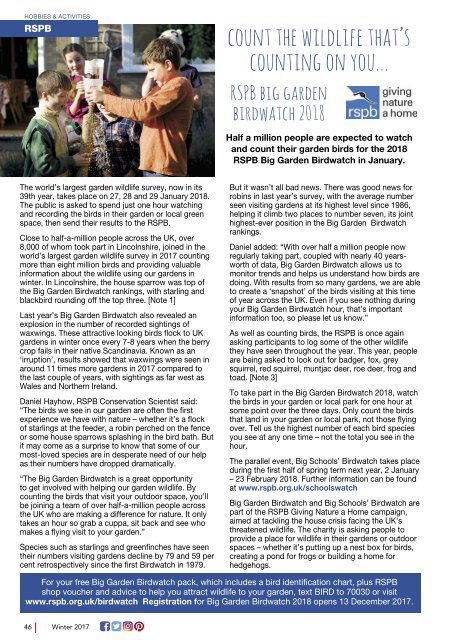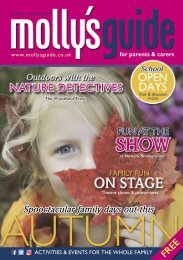molly_issue29_winter_WEB
Create successful ePaper yourself
Turn your PDF publications into a flip-book with our unique Google optimized e-Paper software.
HOBBIES & ACTIVITIES<br />
RSPB<br />
count the wildlife that’s<br />
counting on you...<br />
RSPB big garden<br />
birdwatch 2018<br />
Half a million people are expected to watch<br />
and count their garden birds for the 2018<br />
RSPB Big Garden Birdwatch in January.<br />
The world’s largest garden wildlife survey, now in its<br />
39th year, takes place on 27, 28 and 29 January 2018.<br />
The public is asked to spend just one hour watching<br />
and recording the birds in their garden or local green<br />
space, then send their results to the RSPB.<br />
Close to half-a-million people across the UK, over<br />
8,000 of whom took part in Lincolnshire, joined in the<br />
world’s largest garden wildlife survey in 2017 counting<br />
more than eight million birds and providing valuable<br />
information about the wildlife using our gardens in<br />
<strong>winter</strong>. In Lincolnshire, the house sparrow was top of<br />
the Big Garden Birdwatch rankings, with starling and<br />
blackbird rounding off the top three. [Note 1]<br />
Last year’s Big Garden Birdwatch also revealed an<br />
explosion in the number of recorded sightings of<br />
waxwings. These attractive looking birds flock to UK<br />
gardens in <strong>winter</strong> once every 7-8 years when the berry<br />
crop fails in their native Scandinavia. Known as an<br />
‘irruption’, results showed that waxwings were seen in<br />
around 11 times more gardens in 2017 compared to<br />
the last couple of years, with sightings as far west as<br />
Wales and Northern Ireland.<br />
Daniel Hayhow, RSPB Conservation Scientist said:<br />
“The birds we see in our garden are often the first<br />
experience we have with nature – whether it’s a flock<br />
of starlings at the feeder, a robin perched on the fence<br />
or some house sparrows splashing in the bird bath. But<br />
it may come as a surprise to know that some of our<br />
most-loved species are in desperate need of our help<br />
as their numbers have dropped dramatically.<br />
“The Big Garden Birdwatch is a great opportunity<br />
to get involved with helping our garden wildlife. By<br />
counting the birds that visit your outdoor space, you’ll<br />
be joining a team of over half-a-million people across<br />
the UK who are making a difference for nature. It only<br />
takes an hour so grab a cuppa, sit back and see who<br />
makes a flying visit to your garden.”<br />
Species such as starlings and greenfinches have seen<br />
their numbers visiting gardens decline by 79 and 59 per<br />
cent retrospectively since the first Birdwatch in 1979.<br />
But it wasn’t all bad news. There was good news for<br />
robins in last year’s survey, with the average number<br />
seen visiting gardens at its highest level since 1986,<br />
helping it climb two places to number seven, its joint<br />
highest-ever position in the Big Garden Birdwatch<br />
rankings.<br />
Daniel added: “With over half a million people now<br />
regularly taking part, coupled with nearly 40 yearsworth<br />
of data, Big Garden Birdwatch allows us to<br />
monitor trends and helps us understand how birds are<br />
doing. With results from so many gardens, we are able<br />
to create a ‘snapshot’ of the birds visiting at this time<br />
of year across the UK. Even if you see nothing during<br />
your Big Garden Birdwatch hour, that’s important<br />
information too, so please let us know.”<br />
As well as counting birds, the RSPB is once again<br />
asking participants to log some of the other wildlife<br />
they have seen throughout the year. This year, people<br />
are being asked to look out for badger, fox, grey<br />
squirrel, red squirrel, muntjac deer, roe deer, frog and<br />
toad. [Note 3]<br />
To take part in the Big Garden Birdwatch 2018, watch<br />
the birds in your garden or local park for one hour at<br />
some point over the three days. Only count the birds<br />
that land in your garden or local park, not those flying<br />
over. Tell us the highest number of each bird species<br />
you see at any one time – not the total you see in the<br />
hour.<br />
The parallel event, Big Schools’ Birdwatch takes place<br />
during the first half of spring term next year, 2 January<br />
– 23 February 2018. Further information can be found<br />
at www.rspb.org.uk/schoolswatch<br />
Big Garden Birdwatch and Big Schools’ Birdwatch are<br />
part of the RSPB Giving Nature a Home campaign,<br />
aimed at tackling the house crisis facing the UK’s<br />
threatened wildlife. The charity is asking people to<br />
provide a place for wildlife in their gardens or outdoor<br />
spaces – whether it’s putting up a nest box for birds,<br />
creating a pond for frogs or building a home for<br />
hedgehogs.<br />
For your free Big Garden Birdwatch pack, which includes a bird identification chart, plus RSPB<br />
shop voucher and advice to help you attract wildlife to your garden, text BIRD to 70030 or visit<br />
www.rspb.org.uk/birdwatch Registration for Big Garden Birdwatch 2018 opens 13 December 2017.<br />
46<br />
Winter 2017

















